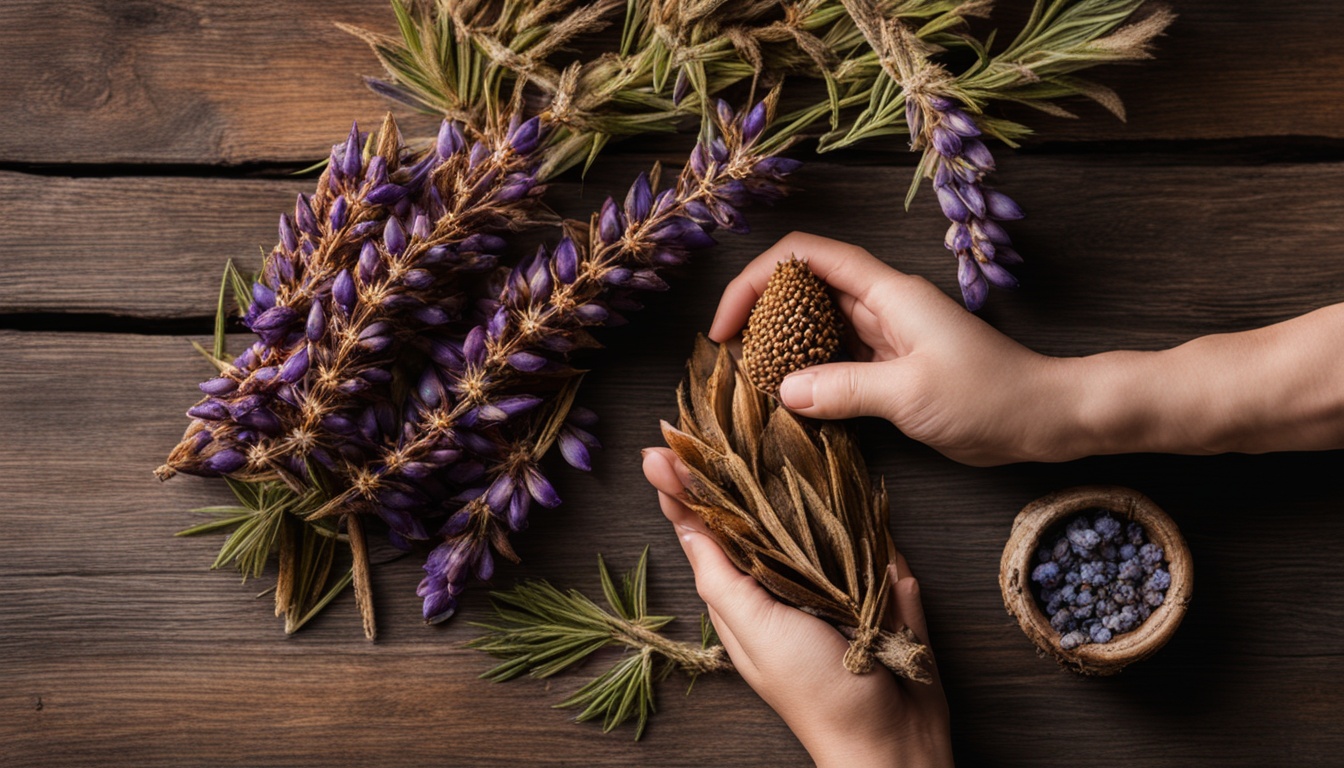Learn the simple steps to harvest lupine seeds. Lupine is a beautiful plant that adds color and beauty to gardens. It’s important to know how to harvest and store lupine seeds to grow more of these lovely plants.
Harvesting lupine seeds is easy. Wait until the seed heads turn dry and brown, usually in late July to early August. Harvest on dry, sunny days to avoid seed rot. Lupine seeds have a special coat that helps them survive the winter and germinate in early spring.
After picking the right time to harvest, you need to collect and process the seeds. With some knowledge, you can keep your seeds fresh and ready for planting. We’ll share tips on when to harvest, how to handle the seeds, and how to store them for later.
What are Lupine Plants?
Lupine plants, or lupinus, are a type of perennial that grow in many parts of North America. They are known for their bright flowers that come in colors like blue, yellow, white, and sometimes red. These plants are great for gardens, especially in cottage or border areas, where they can be a big part of the look during the growing season.
Native Perennial Flowering Plant
Lupine plants come back every year, making them easy for gardeners. They grow in many places in the U.S., doing well in well-drained soil and sunny spots. These plants can grow from 10 to 35 centimeters tall, with beautiful leaves and flower spikes that really stand out.
Vibrant Colors and Striking Flower Spikes
Lupine plants have bright and varied flower colors. You can find them in solid colors like blue, yellow, or white, or in bi-colored spikes that look amazing. These spikes can be up to 20 centimeters long, adding a bold and eye-catching look to any garden.
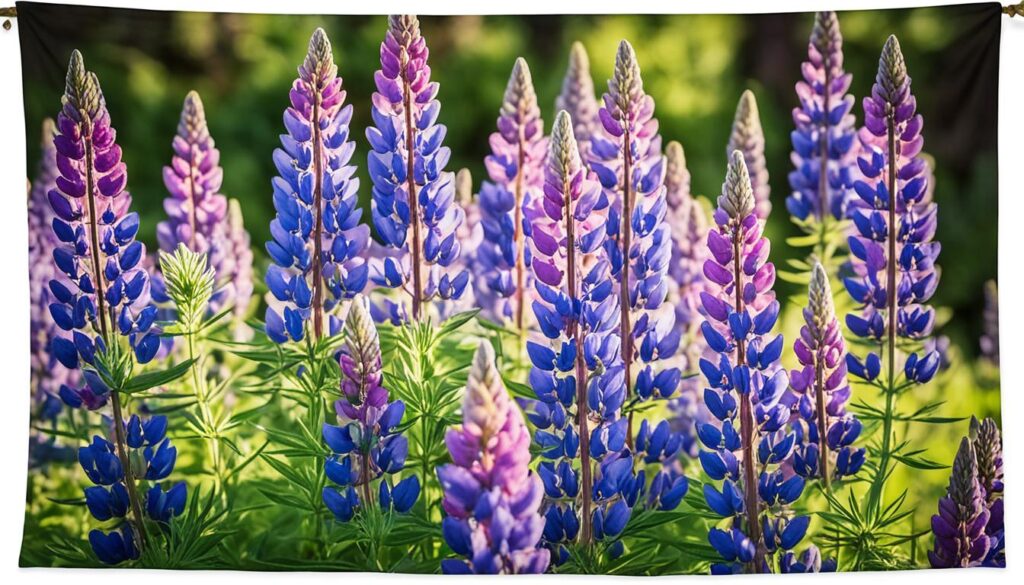
“Lupine plants are a welcomed addition to any garden, particularly in cottage-style or border settings, where their showy flowers can make a bold statement throughout the growing season.”
When to Harvest Lupine Seeds
Harvesting lupine seeds at the right time is key. The best time is usually from late June to August. This depends on when your lupine plants bloom. If you haven’t cut off the flowers after the first bloom, you can collect seeds during this period.
Late June to August for First Bloom
Lupines that haven’t been deadheaded will have their first flowers mature in late June to August. Keep an eye on the seed pods as they turn from green to brown or black. When they’re covered in white “hairs,” it means the seeds are ready to be picked.
Late August Onwards for Second Bloom
If you cut off the flowers after the first bloom, you’ll get a second set of flowers in late summer. The seeds from these flowers will be ready from late August into the fall. Look for the pods to change color and get white hairs to know the seeds are ripe.
It’s important to harvest lupine seeds at the perfect time. If you pick them too early, they might not be fully developed. Waiting too long might cause the pods to open and scatter the seeds. With careful observation and patience, you can harvest your lupine seeds just right.
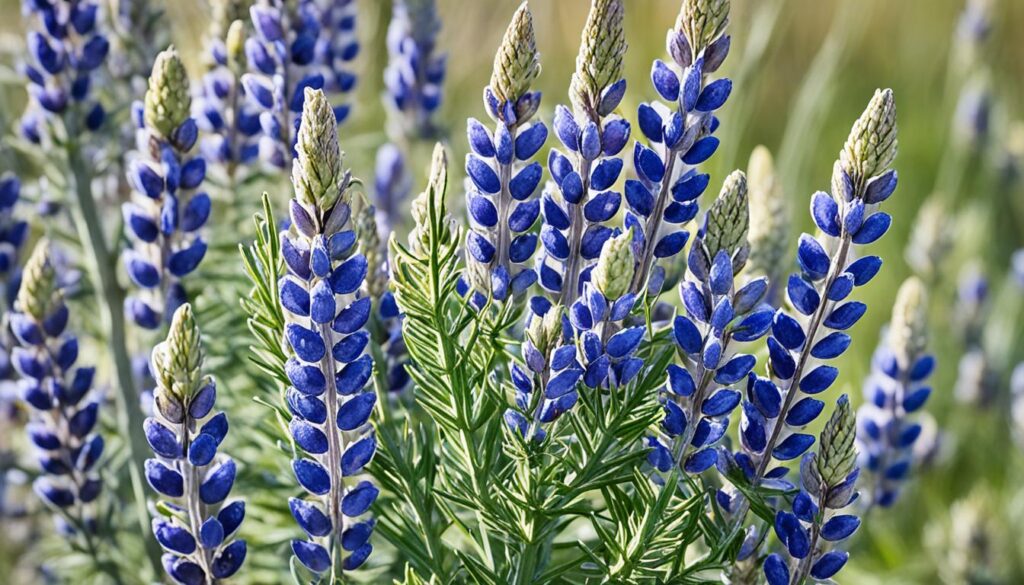
“Lupines are a stunning addition to any garden, and harvesting their seeds is a rewarding experience. By understanding the proper timing, you can ensure a bountiful crop year after year.”
How to Harvest Lupine Seeds
Harvesting lupine seeds is a rewarding process. It lets you collect and spread these beautiful flowers. There are two main ways to do this: cutting the flower spike at the base or removing seed pods by hand. Let’s look at each method closely.
Cutting the Flower Spike
To get the most seeds, cut the flower spike at the base. Use sharp snips or secateurs when the seed pods are dry and brown to black. This way, you get all the seed pods at once.
Removing Seed Pods by Hand
You can also remove the individual seed pods from the flower spike by hand. This is good if you want the lupine to self-seed in the same spot. Make sure to pluck the pods when they’re fully mature.
Choosing the right lupine seed harvesting method is key. It’s important to collect when the pods are dry and ready. With care, you can gather a lot of lupine seeds to enjoy for years.
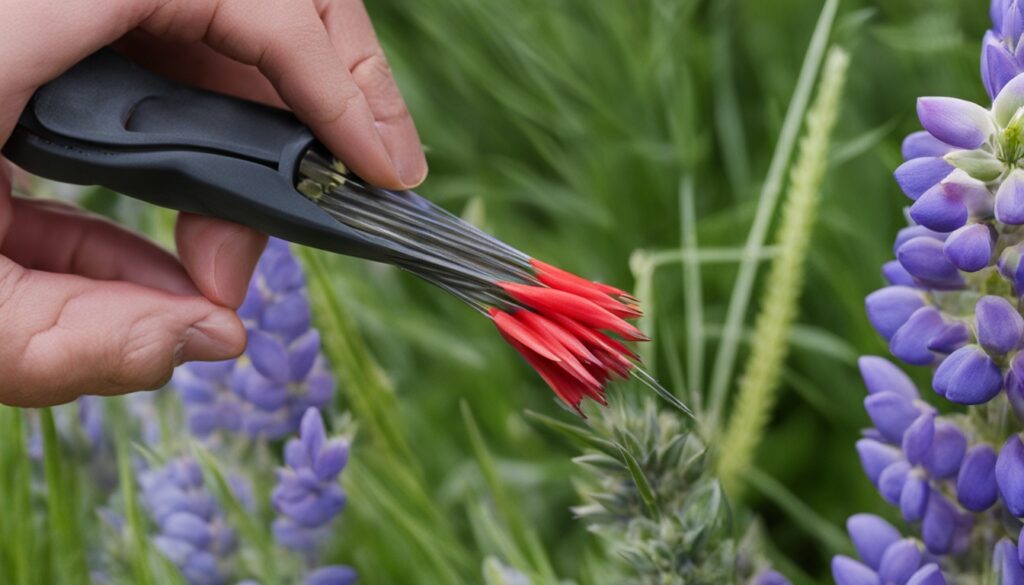
Storing Harvested Lupine Seeds
After harvesting your lupine seeds, it’s key to store them right for later use. Start by removing the chaff, which includes husks, casings, and other plant bits. This keeps your lupine seeds clean and ready for storage.
Next, dry the seeds well. Spread them on paper towels or screens and let them air dry for at least two weeks. This drying is key to stop mold from growing and keep your lupine seeds good for a long time.
Store in Paper Bags or Airtight Containers
The top choices for storing lupine seeds are paper bags or airtight containers like plastic or glass jars with lids. Don’t keep the seeds in direct sunlight or damp places, as this can cause mold. With proper drying and storage, lupine seeds can last for many years, letting you enjoy your harvest for future seasons.
| Lupine Seed Storage Tips | Benefits |
|---|---|
| Remove chaff | Helps maintain seed quality and purity |
| Thoroughly dry seeds | Prevents mold growth and extends seed life |
| Store in paper bags or airtight containers | Protects seeds from moisture and light |
| Avoid direct sunlight and damp conditions | Maintains optimal storage environment |
By following these easy steps, you can make sure your lupine seeds are stored right and ready for planting when needed. With the right storage, you’ll get to enjoy the beautiful blooms of your lupine plants for many years.
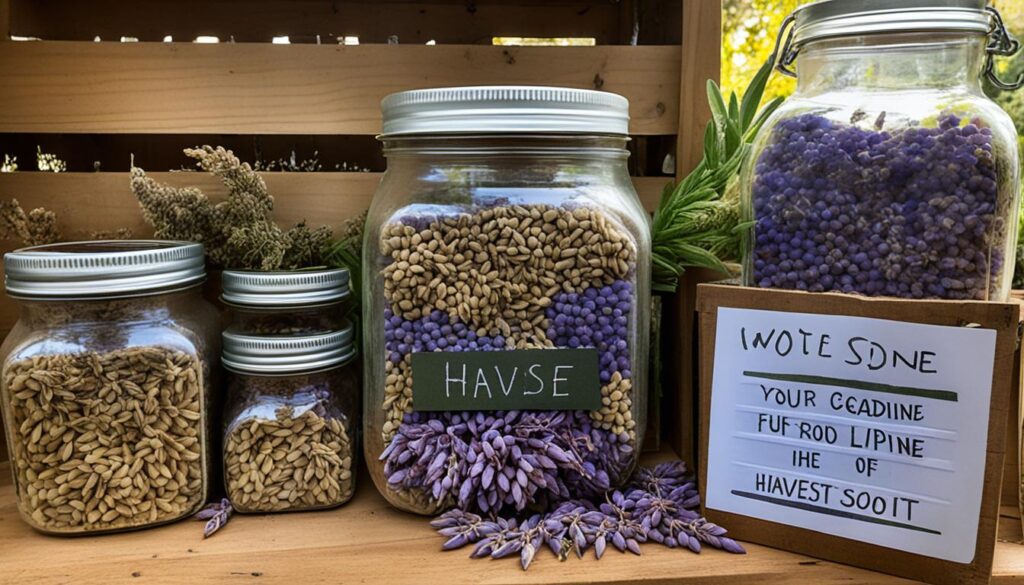
Preparing Lupine Seeds for Planting
Growing lupine plants from seed is rewarding but needs some prep for success. Lupine seeds have a tough coat that helps them survive winter and wait for spring. To mimic this, put the lupine seeds in the fridge for at least 30 days before planting.
This cold, moist period breaks down the seed coat and boosts lupine seed germination. Soaking the lupine seeds in water overnight before planting also helps them sprout better. With these steps, your lupine plants will grow well in your garden.
Stratification Process for Germination
To get the lupine seeds ready, you must stratify them. Put the seeds in a resealable bag or container and keep them in the fridge for at least 30 days. This cold, moist setting breaks down the seed coat and starts germination.
Soaking Seeds Before Sowing
Soaking the lupine seeds in water overnight also helps germination. Put the seeds in a bowl of water and let them soak for 8-12 hours before planting. This softens the seed coat and makes sprouting faster and more even.

By following these steps to prepare lupine seeds for planting, you’re on your way to a beautiful lupine garden.
Growing Lupine Plants from Seed
Growing lupine from seed is rewarding and saves money. It’s a great way to add vibrant flowers to my garden. I can either sow the seeds directly outdoors or start them indoors and then transplant them.
Sowing Lupine Seeds in Fall or Spring
Sowing lupine seeds in the fall is the easiest way. This lets the seeds go through a natural process over winter. Then, they germinate better in the spring.
Or, I can start the seeds indoors 4-8 weeks before planting outside. I’ll use a well-draining mix and give the seedlings lots of sunlight or grow lights. This helps them grow strong.
Transplanting Lupine Seedlings Outdoors
When my lupine seedlings have true leaves and strong roots, it’s time to move them outside. Lupine roots are sensitive, so I shouldn’t wait too long. This is true in the spring or early fall.
With the right care, like keeping them moist and not crowding them, my lupine seedlings will do great. They’ll give me beautiful flower spikes.
FAQ
What are lupine plants?
Lupine plants are a type of perennial that grow in many parts of North America. They are known for their bright colors and tall flower spikes. Adding them to your garden can make it look beautiful.
When is the best time to harvest lupine seeds?
Harvest lupine seeds from late June to August, based on when your plants bloom. If you didn’t cut the flowers after the first bloom, seeds will be ready in late June to August. If you cut the first flowers, the second bloom will be ready for harvesting in late August.
How do I harvest lupine seeds?
You can harvest lupine seeds by cutting the whole flower spike or by removing seed pods one by one. Cutting the spike is best for getting many seeds. Or, you can take out the seed pods by hand.
How do I store harvested lupine seeds?
After harvesting, store lupine seeds well for later use. First, separate the seeds from the chaff, which includes husks and other plant parts. Then, dry the seeds well before storing them. Use paper bags or airtight containers like plastic or glass jars with lids for storage.
How do I prepare lupine seeds for planting?
Lupine seeds have a hard coat that helps them survive winter and wait for spring. To mimic this, keep the seeds in the fridge for at least 30 days before planting. Soaking the seeds in water overnight before planting can also help them sprout better.
How do I grow lupine plants from seed?
Growing lupine from seed is easy, either by direct sowing or starting indoors and moving the seedlings outside. Sowing seeds in the fall is best, as it lets them go through winter stratification for better spring germination. Or, start seeds indoors 4-8 weeks before you plan to plant them outside.
